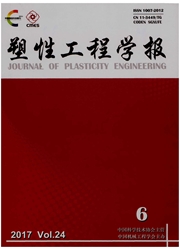

 中文摘要:
中文摘要:
通过Gleeblel500热模拟试验,选择纯铁作为挤压包套材料,然后对非晶合金在390℃、应变速率8.9×10^-1S^-1的条件下进行了静液挤压。Zr非晶合金产生了塑性变形,但没有发生均匀粘滞性流动,而是断裂成两段。样品断口上随机分布着充分与未充分发展的“脉纹”状切变带,并且断面上出现了类似流动熔体凝固后的特征结构。高应变速率变形条件使非晶合金产生的非均匀流变,以及静液挤压时纯铁先于非晶合金的流动变形是造成非晶合金断裂的主要原因。挤压态非晶合金的过冷液相区减小,热稳定性有所降低。
 英文摘要:
英文摘要:
Through the uniaxial compressive deformation test, iron was selected as sheath materials for extrusion of bulk amorphous alloy because of their similar deformation behavior under the testing conditions. Then the bulk amorphous alloy was processed by hydrostatic extrusion at 390℃ and strain rate of 8.9×10^-1s^-1. It shows that the alloy has undergone plastic elongation, however, the alloy did not show uniform viscous flow behavior and fractured into two sections. The fracture surfaces were revealed randomly distributed well developed and partially developed veinal patterns, and a different pattern appeared on the fracture surface which is very similar to the flowing-liquid solidified immediately. The main reason of fracture of the alloy may be attributed to nonuniform flow under the high strain rate and relative motion between the alloy and the iron sheath during hydrostatic extrusion. And it was found that the supercooled liquid region of the extruded sample became narrower indicating the thermal stability was lowered.
 同期刊论文项目
同期刊论文项目
 同项目期刊论文
同项目期刊论文
 期刊信息
期刊信息
